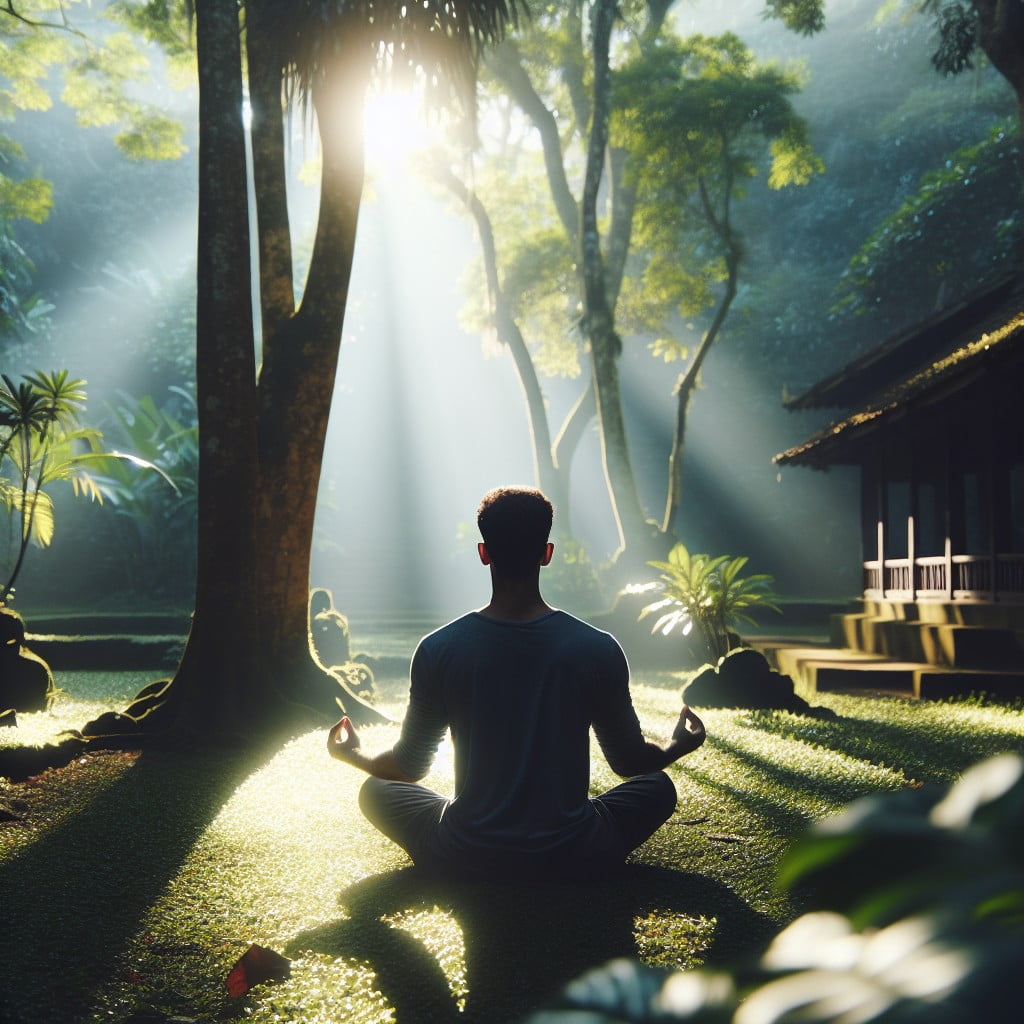Discover the empowering possibilities of independent meditations because it not only helps in refining focus but also enhances self-awareness and peace.
Embarking on a meditation journey without guidance can seem daunting, yet it’s entirely possible and can be a deeply personal and rewarding experience. This article will guide you through the process, providing practical steps and tips to help you meditate effectively on your own.
You’ll learn how to create a conducive environment, establish a routine, and practice mindfulness, all without the need for external guidance. Every detail you need to navigate this self-guided meditation journey is right here, ensuring you can confidently cultivate inner peace and mindfulness.
Key takeaways:
- Autonomy: Independent meditation promotes self-sufficiency and personal growth.
- Flexibility: Customize meditation techniques to suit individual needs and preferences.
- Persistence: Self-discipline is crucial for maintaining motivation and consistency.
- Accessibility: Meditate at your own pace and convenience without external limitations.
- Benefits: Tailored meditation, improved focus, and heightened self-awareness.
Understanding the Concept of Independent Meditation

At the heart of independent meditation lies the ability to channel inner peace and achieve tranquility without external assistance. It’s a profound process of connecting with yourself on a deeper level.
Here are some central points that portray its essence:
- Autonomy: Independent meditation fuels self-sufficiency, allowing one to dictate their path towards relaxation and enlightenment.
- Introspection: The practice provides an opportunity to explore inner thoughts and feelings, fostering personal growth.
- Flexibility: Freedom to tailor techniques and practices based on individual needs promotes adaptability.
- Persistence: Without guidance, maintaining motivation can be challenging. Therefore, self-discipline becomes key to consistency.
- Accessibility: The ability to meditate at one’s pace and convenience becomes a realizable reality with independent meditation.
Techniques to Meditate Without Guidance

To begin, choose a quiet, comfortable spot where you won’t be disturbed. Wear comfortable clothing and you may want to sit on a cushion or chair. Dedicate a specific time for meditation each day, where you can remain consistent.
Next, decide on the duration of your meditation. As a beginner, starting with a few minutes and then gradually increasing is recommended.
Decide on a meditation technique. You can focus on your breath, body sensations, or a mantra. Find one that resonates with you and stick to it during your practice.
Close your eyes or maintain a soft gaze to reduce external stimuli. As distractions arise, gently bring your attention back.
Recognize that your mind will wander. The goal isn’t to empty the mind, but to be present with what arises without judgment. When you catch yourself lost in thought, gently guide your attention back.
Lastly, at the end of the meditation, take a few moments before getting up. Gradually transition back into your day, taking the sense of peace and mindfulness with you. Remember, meditation is a practice, not a perfect. Stay patient and persistent.
Benefits and Challenges of Self-guided Meditation

Embarking on the venture of self-guided meditation fosters a heightened sense of independence. It allows practitioners to tailor their meditation in harmony with their unique needs and schedules. Flexibility in choosing your environment – be it a tranquil park or a quiet corner at home – is another valuable prospect, cultivating a space conducive to introspection and calm.
Additionally, self-guided meditation inculcates patience and discipline. With no external prompts, maintaining focus becomes a commendable triumph achieved through consistent practice.
However, there are challenges to anticipate. The lack of professional input may leave some practitioners feeling uncertain about the correctness of their approach. This uncertainty, coupled with potential distractions in chosen environments, might result in disrupted concentration. The absence of a scheduled class could also lead to inconsistency, affecting the efficacy of the meditation practice.
Practitioners need to approach these challenges as opportunities for personal growth, developing their self-awareness, focus, and commitment to their mindfulness journey.
Practical Tips for Achieving Effective Self-meditation

To embark on a fulfilling self-meditation journey, consider these practical tips:
- Find a Calm Environment: Choose a quiet, comfortable space where distractions are limited. This helps in focusing your mind.
- Preset a Timer: Start with brief periods, around 5-10 minutes daily, gradually increasing duration over time.
- Relax Your Body: Use techniques such as deep, slow breaths, relaxing each body part systematically.
- Mind Your Posture: Sit in an upright, comfortable position, maintaining a gentle level of alertness.
- Anchor Your Mind: Concentrate on your breath, or focus on a word (mantra) to prevent the mind from wandering.
- Practice Non-judgment: Expect wandering thoughts. It’s a part of the process. Gently acknowledge them without self-criticism, and re-focus.
- Be Consistent: Practice meditation daily at a regular time to develop this beneficial habit.
Each point provides a building block for creating a self-sustainable meditation practice. By following these suggestions, you will lay the groundwork for a rewarding and effective self-meditation experience.
Common Mistakes to Avoid During Self-guided Meditation
As a solitary meditator, it’s easy to fall into various pitfalls. Here are a few to keep in mind:
- Striving for Perfection: With no guide to follow, one might feel the need to perfect every session. However, meditation is about the process, not the endpoint. It’s okay to have imperfect sessions.
- Rushing the Process: Patience is key in meditation. Avoid rushing towards achieving deep relaxation or enlightenment. Instead, relish each moment for what it is.
- Neglecting Consistency: Regularity is essential when meditating without guidance. Make a commitment to meditate daily, even if for small periods, to build a strong habit.
- Avoiding Physical Discomfort: Sitting for extended periods can cause discomfort. Instead of avoiding this, acknowledge the sensation as part of the meditative practice.
- Expecting Immediate Results: Mindful meditation is a practice of cultivation and growth which takes time. Let go of the expectation for quick results to avoid disappointment and maintain motivation.
- Ignoring Your Unique Needs: Every person’s experience with meditation is unique and what works for one may not work for another. Adapt your practice to fit your specific needs and circumstances.
Remember, it’s your journey. Go at your own pace, with an open mind and a soft heart. Adapt as necessary, but, most importantly, keep meditating.
Incorporating Mindfulness Into Self-mediated Practice
Practising mindfulness breathes life into your self-guided meditation. It is an ongoing process that begins with understanding the simple act of being present. Begin the journey by developing awareness of your breathing. Focusing on the in and out of your breath anchors you in the present moment, letting your mind break free from past worries or future anticipations.
Gradually extend mindfulness to sensory experiences – the feel of the wind, the sound of the rain, or the taste of your morning coffee. This engagement with the present enriches your meditation experience, making it deeper and more fulfilling.
Encourage a non-judgmental outlook. As you meditate, thoughts and emotions will arise. Observe them without labeling as ‘good‘ or ‘bad‘. Each thought is an opportunity for awareness, not a distraction to be pushed away.
Lastly, consistency over intensity reigns supreme. Dedicate a few minutes daily to mindfulness in your meditation. Watch as patience, understanding, and peace start manifesting organically, enhancing not just your meditation practice, but your life as a whole.
Evolving Your Self-guided Meditation Practice: Sustaining Your Progress
Regular consistency, continual adaptation and patient practice form the backbone of a sustainable self-guided meditation regimen. To begin, maintaining a consistent meditation routine is vital. It builds a habit, conditioning the mind to enter meditative states more easily over time.
Next, your meditation practice must continually evolve to meet your changing needs. It’s important to remember that there isn’t one “correct” way to meditate. Experiment with different methods. Hash out a routine that works best for you, based on your personal comfort levels and the effects each method has on your peace of mind.
Lastly, remember that patience is key. Progress may seem slow in the beginning, but positive changes will become more evident with each meditation session. Allowing the mind to meander naturally during meditation can result in a more profound connection with your inner self.
Reflecting on these points can assist in fostering an enjoyable, effective, and sustainable self-guided meditation practice.
FAQ
How to do a non guided meditation?
To do a non-guided meditation, sit in a quiet space and focus on your body and thoughts for a predetermined duration.
Is it better to meditate without guidance?
For beginners, guided meditation is typically more beneficial, however, once they gain confidence and experience, solo meditation can be equally effective.
What techniques can assist in unassisted meditation?
The use of focus objects, breathing techniques, mantra chanting, and visualization can aid in unassisted meditation.
How can one ensure effective self-guided meditation?
One can ensure effective self-guided meditation by establishing a calm environment, focusing on breathing, practicing body awareness, being patient with oneself, and incorporating daily meditation into their routine.
What are some common challenges one might encounter when meditating without guidance?
Common challenges someone might encounter when meditating without guidance include inability to focus, fear of doing it wrong, trouble finding a comfortable position, and feeling restless or irritable.